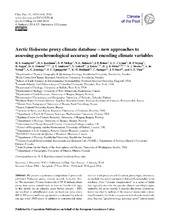| dc.description.abstract | We present a systematic compilation of previously published Holocene proxy climate records from the Arctic. We identified 170 sites from north of 58° N latitude where proxy time series extend back at least to 6 cal ka (all ages in this article are in calendar years before present – BP), are resolved at submillennial scale (at least one value every 400 ± 200 years) and have age models constrained by at least one age every 3000 years. In addition to conventional metadata for each proxy record (location, proxy type, reference), we include two novel parameters that add functionality to the database. First, "climate interpretation" is a series of fields that logically describe the specific climate variable(s) represented by the proxy record. It encodes the proxy–climate relation reported by authors of the original studies into a structured format to facilitate comparison with climate model outputs. Second, "geochronology accuracy score" (chron score) is a numerical rating that reflects the overall accuracy of 14C-based age models from lake and marine sediments. Chron scores were calculated using the original author-reported 14C ages, which are included in this database. The database contains 320 records (some sites include multiple records) from six regions covering the circumpolar Arctic: Fennoscandia is the most densely sampled region (31% of the records), whereas only five records from the Russian Arctic met the criteria for inclusion. The database contains proxy records from lake sediment (60%), marine sediment (32%), glacier ice (5%), and other sources. Most (61%) reflect temperature (mainly summer warmth) and are primarily based on pollen, chironomid, or diatom assemblages. Many (15%) reflect some aspect of hydroclimate as inferred from changes in stable isotopes, pollen and diatom assemblages, humification index in peat, and changes in equilibrium-line altitude of glaciers. This comprehensive database can be used in future studies to investigate the spatio-temporal pattern of Arctic Holocene climate changes and their causes. The Arctic Holocene data set is available from NOAA Paleoclimatology. | en_US |

